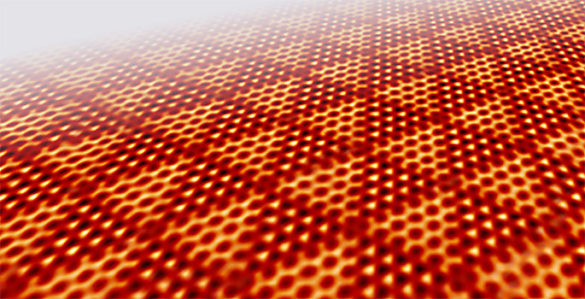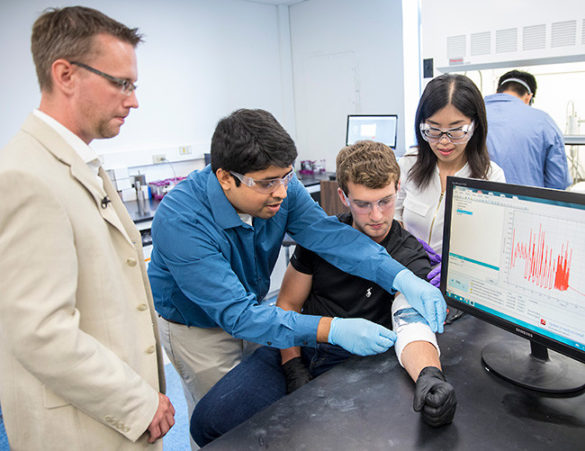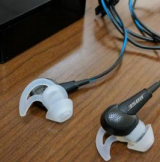Vuitadmin
-

Multitasking monolayers lay groundwork for devices that can do two things at once
Illustration of the triangular pattern formed by the two-dimensional material chalcogenide that allows the creation of dual-function devices. (Yu-Yang Zhang / Chinese Academy of Sciences) Two-dimensional materials that can multitask. That is the result of a new process that naturally produces patterned monolayers that can act as a base… Read MoreJul. 25, 2017
-

Plentiful human protein better carrier for gene therapy in tumors
Powerful molecules can hitch rides on a plentiful human protein and signal tumors to self-destruct, a team of Vanderbilt University engineers found. Their research gives oncologists a better shot at overcoming the problems of drug resistance, toxicity to patients and a host of other barriers to consistently achieving successful gene… Read MoreJul. 24, 2017
-

Engineer’s ultrathin device harvests electricity from human motion
Imagine slipping into a jacket, shirt or skirt that powers your cell phone, fitness tracker and other personal electronic devices as you walk, wave and even when you are sitting down. A new, ultrathin energy harvesting system developed at Vanderbilt University’s Nanomaterials and Energy Devices… Read MoreJul. 21, 2017
-

Engineering faculty lead 3 new TIPs projects that tackle big challenges
Build and use microscope systems that do not exist commercially to unlock deeper insights in biomedicine. Design and develop a space-based platform to study Earth’s evolving ecology from an elevated vantage point. Create a research hub for development and testing of durable, sustainable infrastructure materials. All big ideas with widespread… Read MoreJul. 20, 2017
-

Advanced material analysis focus of ME grad student’s 2 weeks at national labs
A mechanical engineering Ph.D. student will spend two weeks using some the most advanced X-ray and neutron equipment in the world and learning the techniques from top experts. Marm Dixit was among 60 graduate students selected for the 2017 National School on Neutron and X-ray Scattering. As a part… Read MoreJul. 18, 2017
-

BME study shows software helps surgeons find liver tumors, avoid blood vessels
Michael Miga (John Russell / Vanderbilt) The liver is a particularly squishy, slippery organ, prone to shifting both deadly tumors and life-preserving blood vessels by inches between the time they’re discovered on a CT scan and when the patient is lying on an operating room table. Surgeons can swab the exposed liver lightly… Read MoreJul. 17, 2017
-

Bicycle remix: a $25 Craigslist buy, scrap metal tubing, welding and curiosity
When Nick Belsten first eyed the pile of scrap metal tubing, he saw wind chimes. Castoffs from fences installations, the galvanized pipe pieces held too much potential to be ignored. Belsten packed as much as he could around furniture and other household goods headed to his family’s home in Florida. Read MoreJul. 11, 2017
-

Mechanical engineering students devise locking system for Nashville public art
When the Nashville Public Art Program commissioned a series of artistic bicycle racks, city officials did not expect vandals to remove one and stick it up in a tree. Outright theft was another problem. Maintenance presented still others. When a rack needs attention, workers have had to break up concrete… Read MoreJul. 6, 2017
-

PhD student wins summer grant to study potential vaccine for pediatric neuroblastoma
A grant from cancer research nonprofit Alex’s Lemonade Stand Foundation is allowing a Vanderbilt chemical engineering doctoral student to advance his research on a potential vaccine against pediatric neuroblastoma. Kyle Garland is spending his summer on a project titled Immunotherapeutic Targeting of the STING Pathway to Combat Neuroblastoma. He’s working… Read MoreJul. 5, 2017
-

BME team develops device to remove ICU alarm noise, improve patient sleep
The ICU is no place to get good rest, as anyone who has worked, visited or stayed in one knows. Alarms designed to alert clinicians disrupt patient sleep, adding to their stress and disorientation. The alarms are shrill, frequent and often false. What if an in-ear device could block a… Read MoreJul. 1, 2017